NORTH WALES COAST RAILWAY:NOTICE BOARD
Rheilffordd arfordir gogledd Cymru: Hysbysfwrdd
27 September 2021




Contributions to the Notice Board are welcome, although they may not always be used, due to time constraints. For more information visit the Contributions Page.
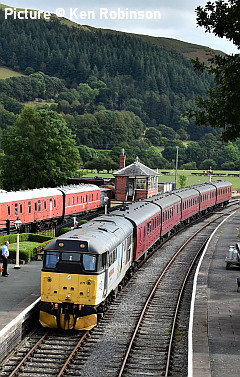
Forthcoming events
Charter trains may be subject to cancellation or postponement.
Wednesday 29 September: North Wales Pullman (West Coast Railways) Diesel: Skegness - Llandudno (break) and return.
Sunday 30 September The Wirral Squirrel (Branch Line Society). Crewe and Liverpool to unusual track in the Wirral and Merseyside area. Locos D213 and D345.
October 2021
Monday 18 October RCTS Chester Mike Lister The Railways Of Port Sunlight
November 2021
Saturday 13 November The Cheshireman (Railway Touring Company) Steam: 60163 Bristol - Hereford - Shrewsbury - Wrexham General - Chester (break) and return
Monday 15 November Online Zoom RCTS David Postle Kidderminster Railway Museum
Saturday 20 November The Cheshireman (Railway Touring Company) Steam: 60163 London Euston - Crewe - Chester and return
December 2021
Monday 6 December Chester Christmas Market (Spirit Of The Lakes (West Coast Railways) Diesel: Skegness - Chester and return
Saturday 11 December The Northern Belle: Christmas Lunch Diesel
Crewe - Chester - Liverpool Lime Street and return
Saturday 11 December The Christmas Chester Cracker (Pathfinder Tours) Eastleigh - Gloucester - Newport - Maindee Junction - Abergavenny - Shrewsbury - Crewe - Chester and return
Monday 20 December RCTS Chester Dave Southern Chester To Pwllheli
January 2022
Monday 17 January RCTS online Zoom Professor Stuart Cole Rail Policy in Wales
February 2022
Monday 21 February RCTS Chester Martyn Hilbert Network North WestMarch 2022
Wednesday 2 March RCTS Liverpool Paul Shackcloth L & Y Engines At Work, Part 1
Monday 21 March RCTS online Zoom Geoff Plumb The Wrexham & Shropshire Railway
April 2022
Monday 25 April RCTS Chester David Powell Merseyrail Fleet Replacement(see our Calendar page for venues)
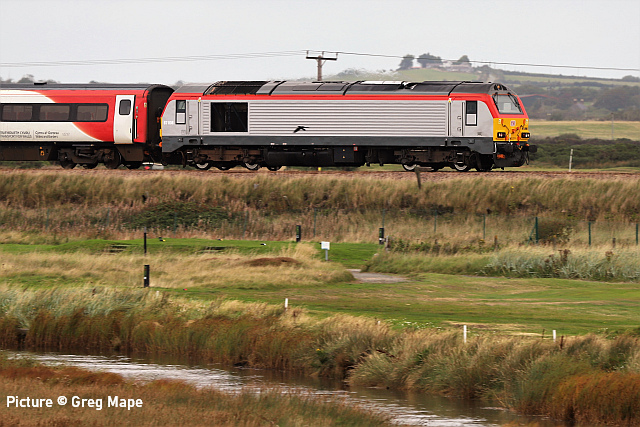
The 11:33 Holyhead - Cardiff train approaching Rhosneigr on 23 September
with 67 008 on the front. Picture by Greg Mape.
Editor's note
Contributors are asked to read the Contributions page, which has been updated. In particular I need - to allow more time for other work - to reduce the time I spend on the site editing and renaming images, creating captions, working out which day was 'Today', etc. Pictures which follow the guidelines are more likely to be included. Thanks in advance.
I have held over a number of Narrow Gauge reports, which will hopefully appear at a later date. - Charlie
Class 197 news
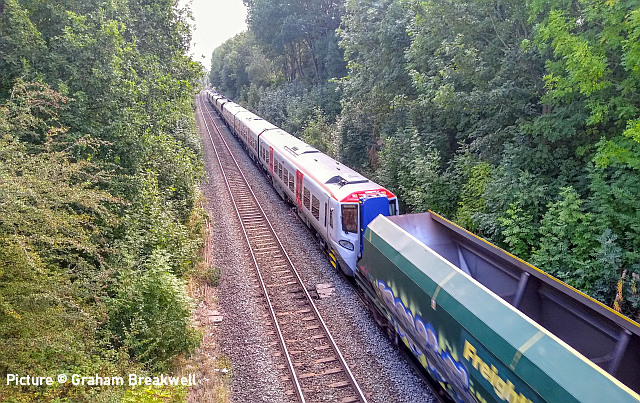
197 101, the first of the three car units to be delivered to TfW, seen from Belvidere bridge, Shrewsbury sandwiched between barrier wagons on the move from Donnington RFT to Crewe LNWR, 24 September.
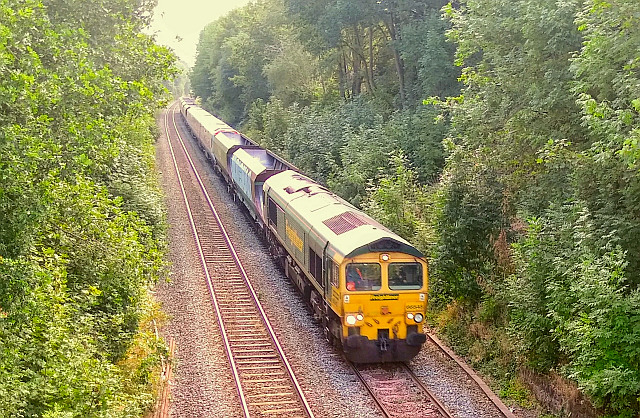
Traction was provided by 66 545. Pictures by Graham Breakwell.
Miscellany
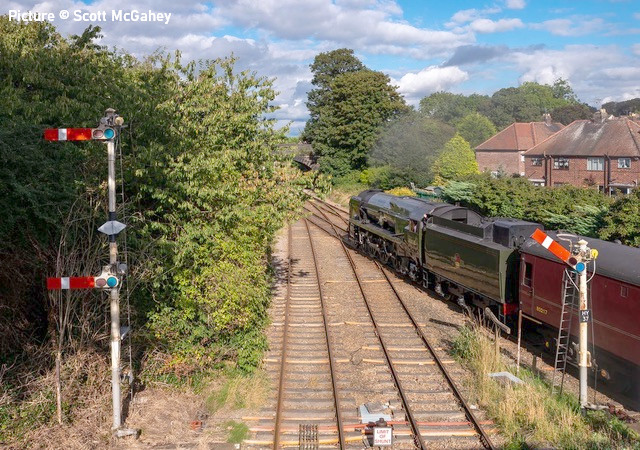
Our question about surviving semaphore signals received several replies, all agreeing that the only survivors are at Helsby, and Greenloaning in Scotland between Stirling and Perth. Scott McGahey made the journey to Helsby on 25 September to bring us this image of 35 018 British India Line, a newcomer to main line steam, returning to Carnforth from Chester with a Luner Rivers Trust charter. For more about co-acting signals, see the Railway World website.
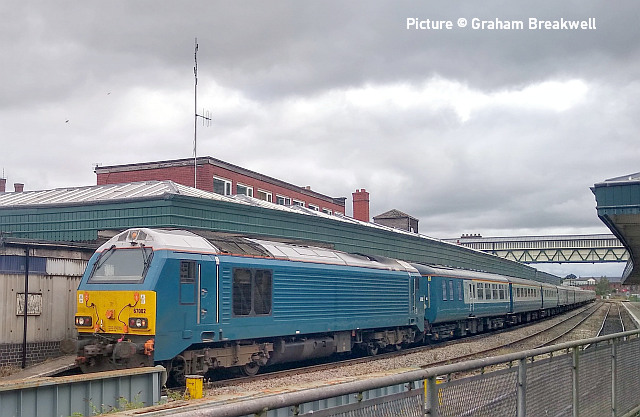
UK Railtours ran their Autumn in Shrewsbury excursion from London Kings Cross on 25 calling at Telford Central for optional trips to Ironbridge and Blists Hill Museum or Attingham Park from Shrewsbury. 67 002 still in its Arriva blue livery from the early days of the Holyhead - Cardiff express, led the 12coach train of 10 blue and grey Mk2s and 2 Mk1 Buffet/restaurant coaches, with 67007 on the rear. The train is seen here after arrival on Shrewsbury's platform 4.
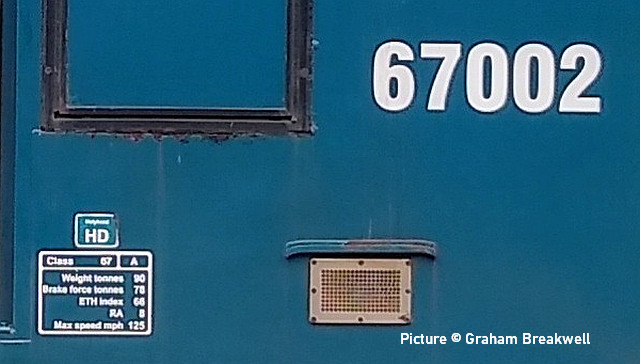
Holyhead's trademark still in place!
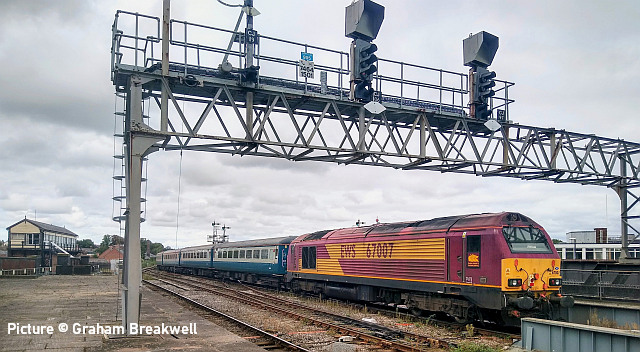
The empty stock heads down to Coton Hill sidings for the afternoon, with 67 007 on the tail to work the return departure at 17:00. Remarkably this loco retains its complete original livery, with no Deutsche Bahn branding in evidence. Recently removed from storage, perhaps to allow others to be transferred to TfW duties, this is one of the 67s that were fitted with the Radio Electric Token Block equipment for use on the West Highland lines. Pictures by Graham Breakwell.
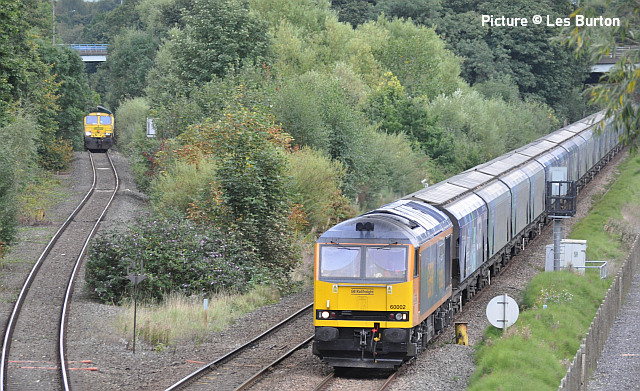
Northenden Junction on 9 September. GBRf 60 002 Graham Farish passes with empty biomass wagons for Liverpool, while 66 598 waits with a stone train from the Peak Forest direction. Picture by Les Burton.
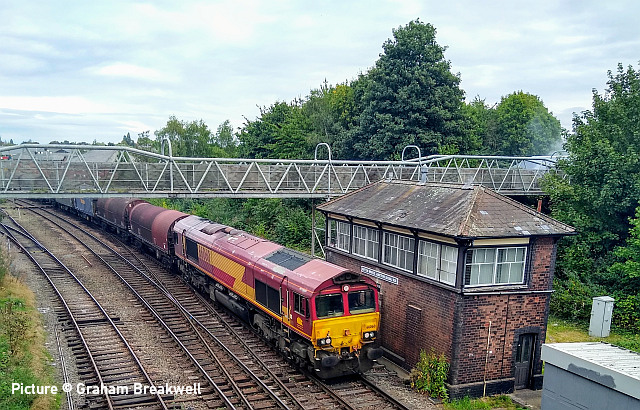
66 060 on the morning steel coils service from Dee Marsh Junction to Margam passing Sutton Bridge Junction signalbox and passing under the long-closed footbridge. The train actually terminated at Llanwern on this day (Graham Breakwell)
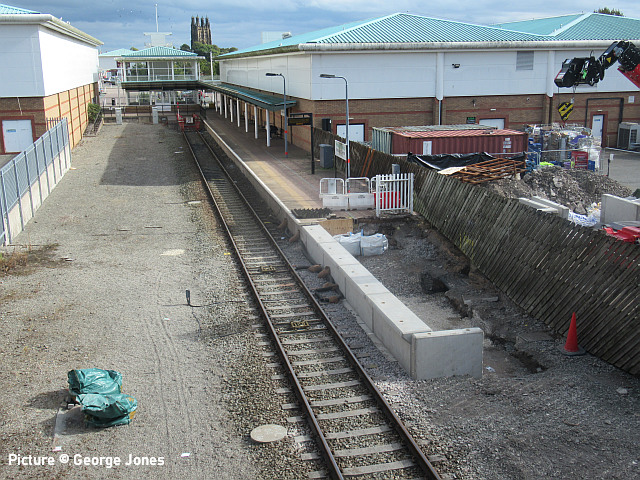
Wrexham Central on 26 September, with work in progress to extend the platform to fit the Class 230 units. When the line was shortened to build a shopping centre, space was left for a possible second track and platform - will it ever be used?
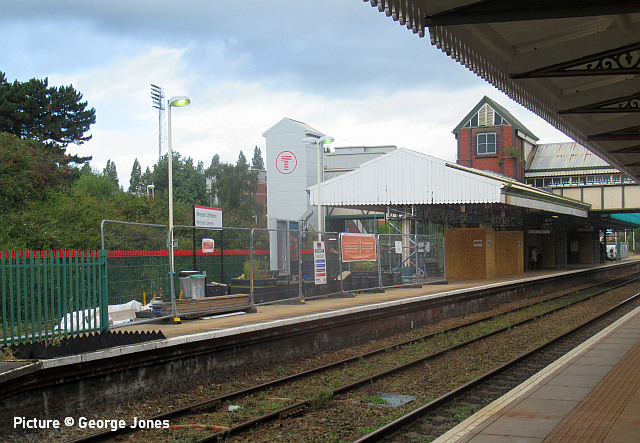
At Wrexham General work has progressed on to platform 2/3 improvements; if platform 1 is anything to go by, this is a canopy re-paint job. Pictures by George Jones, who notes 'Hope they do the gable end and what about the lift tower?''.
TfW's plans updated
Transport for Wales have announced on their website some dates for the service improvements originally intended for 2018. Below is a summary for our area.
Cardiff to Cheltenham (a consistent one train per hour to all stations) – Will be delivered by December 2022 (as originally planned)
Heart of Wales Line (one additional service per day to all stations) – Will be delivered by December 2022 (as originally planned)
Liverpool to Llandudno (new hourly service) – Will be delivered by December 2023 (revised)
Extension to the current Manchester Airport to Llandudno service – Will be delivered by December 2023 (revised)
Aberystwyth to Shrewsbury (a consistent one train per hour to all stations) – Will be delivered by May 2024 (revised)
Hourly service between Liverpool and Shrewsbury – Will be delivered by December 2024
In addition, TfW has successfully purchased a further 25 Mark 4 intercity carriages plus five driving van trailers that are fully refurbished to a high standard. This will include four trains of five carriages which will enter service on the South Wales to Manchester route in 2023.The two services from Liverpool are of interest. A previous announcement referred to a 'Liverpool to Llandudno and Shrewsbury service (1tph) and Liverpool to Cardiff service (1 train every 2 hours)'. It appears that the Cardiff servive has been shelved. Will the Shrewsbury service go via Wrexham or Crewe? The Liverpool - Llandudno is simply an extension of the present Liverpool to Chester via the Halton Chord.
The Manchester Airport service has been under threat of diversion away from the Airport to serve Manchester Victoria and Stalybridge, as part of a plan to reduce congestion in the Manchester Piccadilly area. It appears that protests by the Welsh Government have borne fruit.
Railtours on the Coast ... and elsewhere - by Gary Thomas
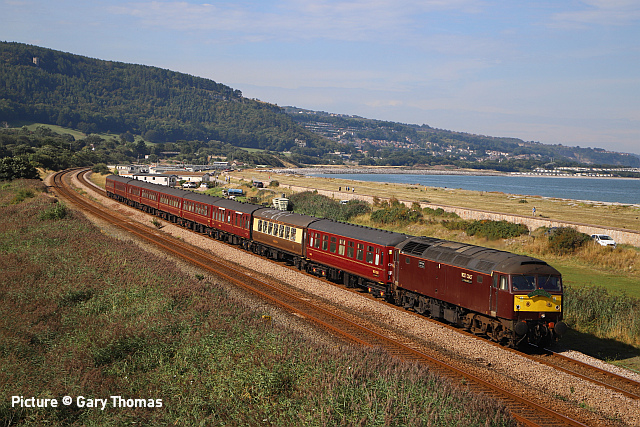
Firstly three photos of two charters on the Coast and what a couple of different day's weather we had! The first is a sunny photo of 47 846 Chris Fudge passing through Pensarn with day 5 of the Welsh Dragon multi-day tour on route from Holyhead to Hereford (with a change to two steam locomotives (45596 and 61306) at Crewe.
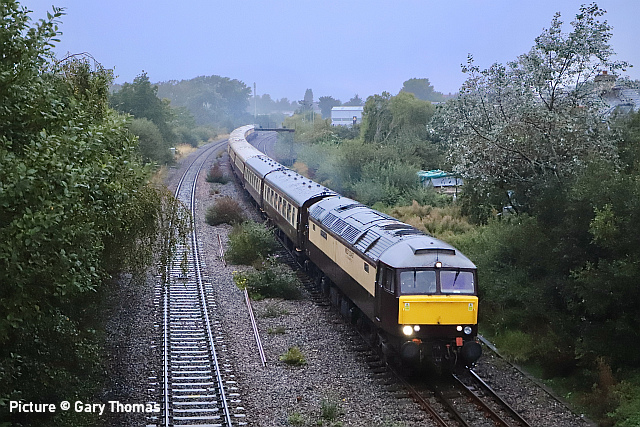
Two days later and two photos of the Llandudno Junction to Scarborough Northern Belle, just passing under Conway Road bridge, with 57 601 Windsor Castle leading ...
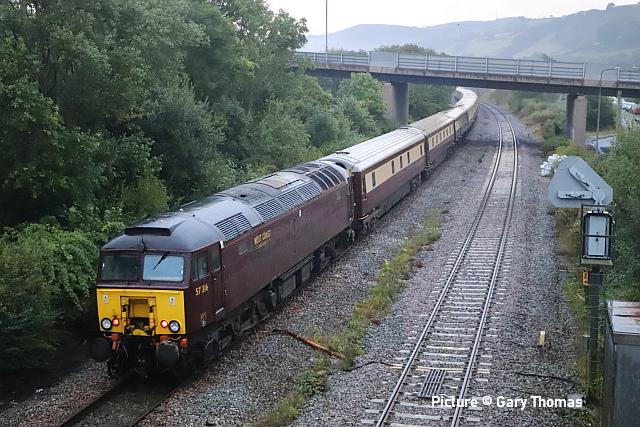
... and 57 316 on the tail. 57 601 also led the return journey.
As a result of the easing of Covid restrictions many delayed rail tours have been running, almost back to back. I thought it would be good to share the most interesting photos from 4 day GBRf 2021 This time it's personal rail tour that started in London Victoria on Thursday 1 September, taking in East Anglia on day 1, the Southampton area on day 2, overnight to Scotland then day 3 to Oban, then finally heading south from Carlisle to London Paddington on the final day.
Despite being delayed one year, the rail tour was not without incident, with minor changes to the itinerary, both in terms of locations visited and also traction, but the majority of that promised was delivered. On train though, many people suffered from Gastroenteritis, leading to the unprecedented view of people being sick out of the windows of moving trains!
The GBRf team, all volunteers managed the incident really well and made a major change on day 3 (the Saturday), so that we ran direct to Carlisle, rather than via Edinburgh, Newcastle and the Tyne Valley, so that unwell people could get some well needed rest.
I took lots of photographs, including of a 59, 73's, 66's, industrial shunters and 08's that all hauled the train but I'd focus on the highlights for me, some North Wales Coast related, though others are more news-worthy.
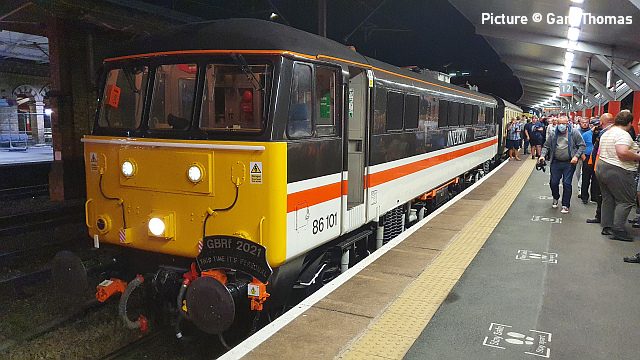
Firstly, here's 86 101 Sir William Stanier FRS at Crewe, with the overnight leg from Kensington Olympia to Exhibition Centre. 86 101 came on at Willesden, taking the train to Mossend Yard to be replaced by 37425 and 37407, both late substitutes, with a class 33 first proposed, followed by 2x20's, who became unavailable at late notice.
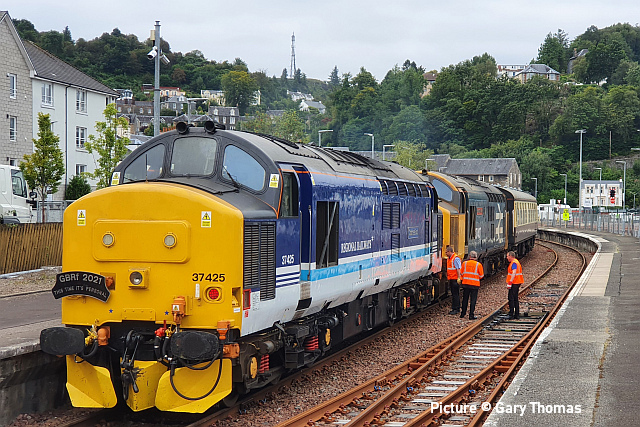
Former Coast stalwarts 37 425 Sir Alfred McAlpine / Concrete Bob ...
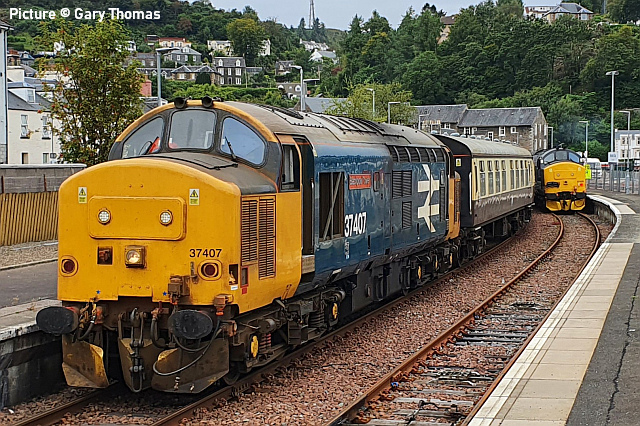
... and 37 407 Blackpool Tower on arrival at Oban. They performed immaculately.
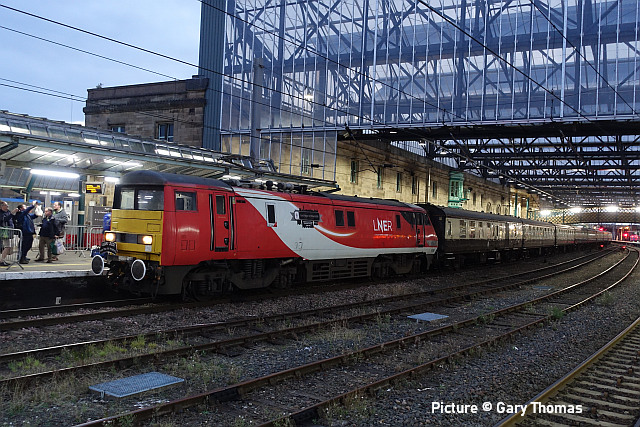
The 37s were replaced by 91130 for the shorter run from Mossend Yard to Carlisle (rather than Newcastle via Edinburgh). A class 91, particularly one facing blunt-end first hadn't hauled Mark 1 carriages for over 30 years.
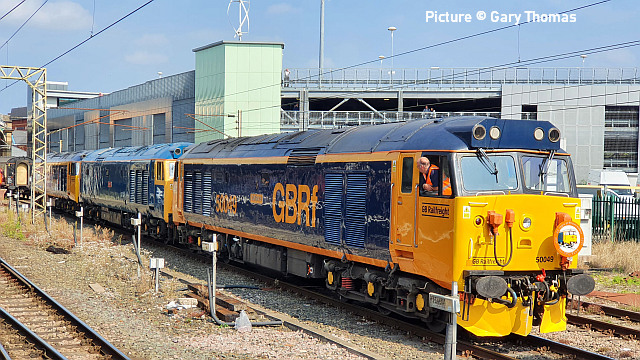
On the last day (day 4), Sunday 5 September were had the first run of 3 class 50's in unison for 30 years, with 50 049 Defiance, 50 044 Exeter and 50 007 Hercules taking the train from Preston to Bescot Yard.
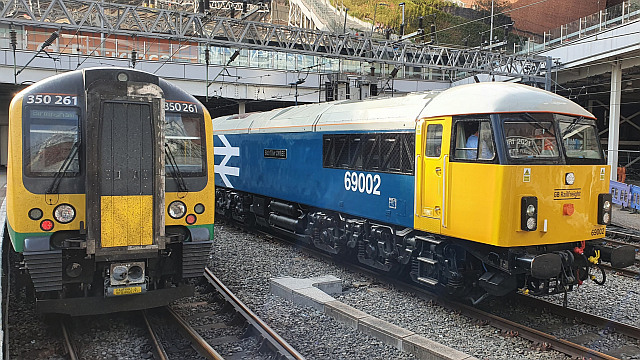
Finally, GBRf's class 56/66 hybrid conversions, the class 69s made their passenger debut, with 69002 Bob Tilier CM&EE ...
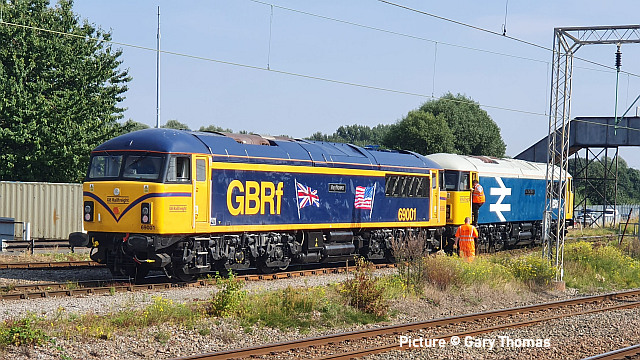
...and 69 001 Mayflower hauling the last leg from Bescot Yard to London Paddington, with a late arrival due to fuel pump issues in the locos.
As I wrote this I was recovering from a day trip to Stranraer with 50 049 and 50 007. I had another trip planned for Penzance the next Saturday, but I decided to take a rest!
TfW's long-term projects - reviewed by Barrie Hughes
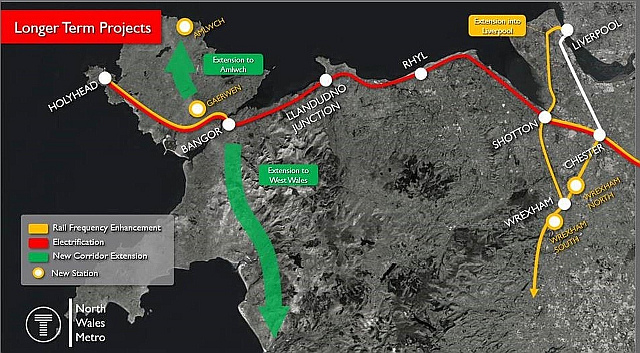
This latest image from the Welsh Government shows a major expansion of North Wales Metro long term plans with a view to encouraging more public transport and helping reduce CO2 emissions to reach the new UK target.
The Bangor-Amlwch train service has been added as has the Bangor-West Wales train service (the Cambrian Coast Line).
While Bangor-Amlwch presents no problem as the track is still there and slowly being cleared by Lein Amlwch volunteers, the same cannot be said about Bangor to Afon Wen junction. If the latter is to be restored, use of the existing trackbed is problematical. Sections of the formation have been lost between Menai Bridge Junction and Caernarfon due to lack of foresight by planners who allowed development on the alignment.
The most difficult length is Bangor-Caernarfon as the A55 needs to be bridged, the Vaynol Tunnel reopened, diversions at both ends of the Y Felinheli Bypass and a new route for the last mile into Caernarfon Station avoiding the Morrison’s Garage.
From Caernarfon Station the Caernarfon Tunnel can revert to rail use as it is little used as a road tunnel. The railway can pass through the Welsh Highland Railway HR station Caernarfon and 'gauntlet' the WHR tracks and operation to Dinas with appropriate signalling.
South of there the trackbed is largely clear to Afon Wen but is shared with the Lon Eifion cycleway for much of its length. Fortunately the builders of the Caernarvonshire Railway purchased land for double track so it is just a question of moving the cycleway to one side.
As regards the target of ‘West Wales’ this might be though to include the Aberystwyth-Carmarthen link which was subject to a feasibility study several years ago. Together with the reconstruction of Bangor - Afon Wen this further step would recreate a through route down the west coast of Wales.
When such improvements might occur is anyone’s guess but the Welsh Government seems to be taking the issue seriously having paused all road schemes in June 2021 for review in light of the Green Transport issues raised by UK targets for climate control.
From Dave Sallery's archive
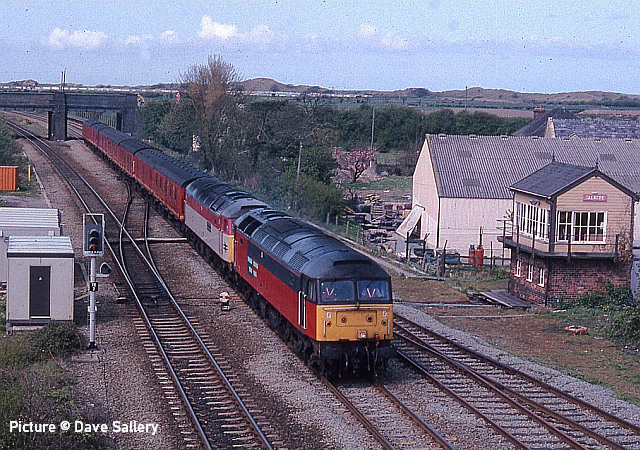
47 761 and 47 972 pass Talacre box on a test train returning to Crewe on 27 April 1995. 972 was in a special livery for Derby Research Centre.
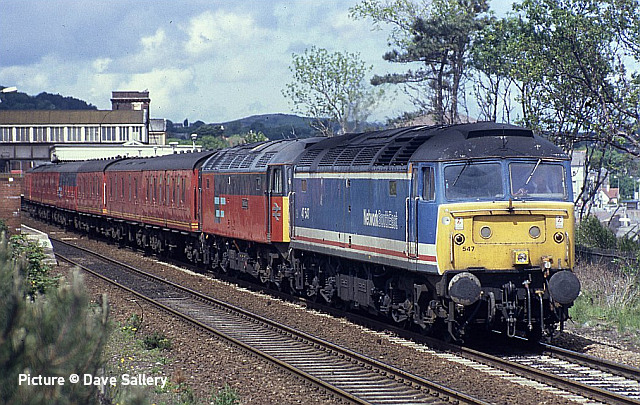
47 547 and 47 741 passing Colwyn Bay, again on test, 25 May 1995. 547 seemed to be rather troublesome as it appeared several times on test around this time.
An accessibility issue examined - by Roger Smith
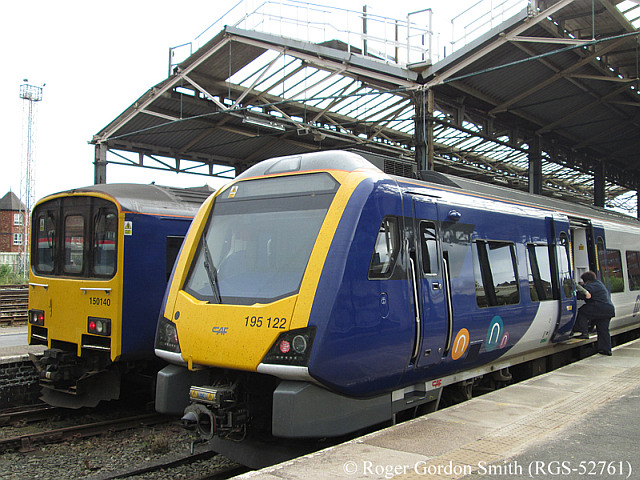
Northern Rail 195 122, a three-car diesel multiple unit, waits in bay Platform 5 at Chester to commence the 1E58, 10:25 Chester to Leeds service. I draw your attention to the difference in height between the door sill and the platform surface. For the lady of short stature, she found it impossible to board the train without being pulled up and in.
I had recently arrived on the same diesel multiple unit, and, before my exiting the station, I thought it useful to return and photograph it. As I approached, I saw this lady placing her hands on the floor of the coach and starting to try to kneel her way in; that is when the assisting hand appeared, as seen in my photograph.
In the adjacent bay, Platform 6, is Northern 150 140, at the rear of a four-car consist, the leading two cars being 156 464. This consist was to form the 2H30, 11:02 Chester to Manchester Piccadilly service.
Looking back: Holyhead ships - by David Pool
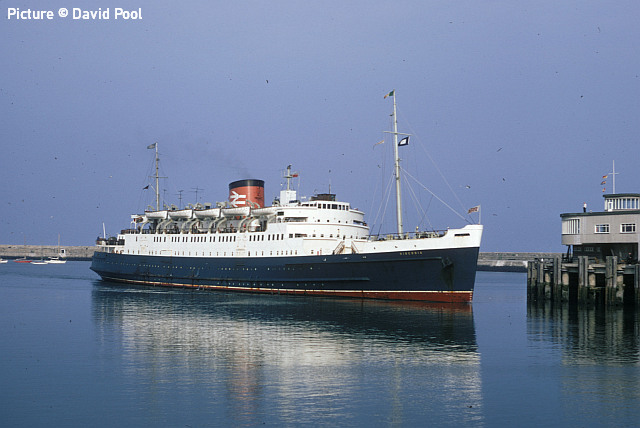
The MV Hibernia and the MV Cambria were two ships built by Harland and Wolff for the Holyhead to Dun Laoghaire service. They were primarily for foot passengers, catering for first and third class travellers on day and night services, although up to 20 cars could be carried, being loaded and unloaded by cranes. The Hibernia entered service in 1949, and continued until 1976. During the Britannia Bridge fire this ship sailed from Heysham, and in 1968 very briefly provided cover for a Harwich to Hoek van Holland service. The photograph was taken a year later on 8 September 1969 arriving at Dun Laoghaire from Holyhead.
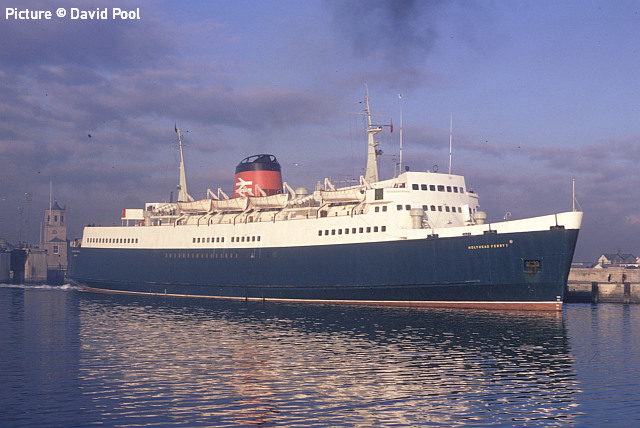
In 1969 the Holyhead Ferry I was the ship on which most of the car traffic between Holyhead and Dun Laoghaire was conveyed. Built by Hawthorn Leslie on the Tyne in 1965, with a capacity of 150 cars, loading was at the stern. It was later converted to a “drive through” vessel, and renamed Earl Leofric, but after a relatively short life and service on a number of Sealink routes withdrawal came at the end of 1980. On 27 December 1969 the ship was moored at Holyhead.
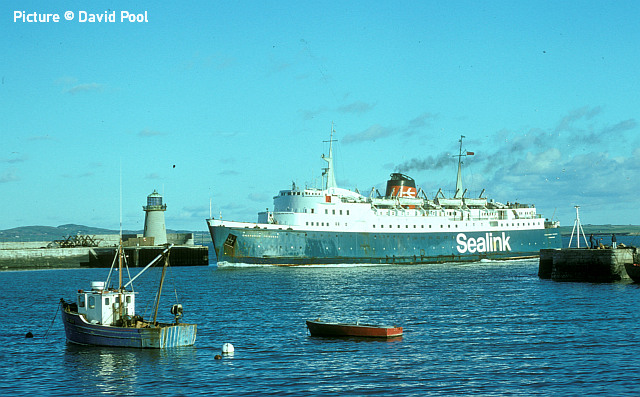
In the 1970s many different Sealink vessels appeared at Holyhead, as they were transferred between different routes. On 28 December 1976 the Caledonian Princess was one such visitor. This was another stern loading vessel, built by William Denny and Brothers in 1961 for the Stranraer to Larne route, it later worked on the Weymouth to the Channel Islands services, and its last Sealink sailing was from Dover in 1981. In the 1980s this ship became the Tuxedo Princess, a floating nightclub on the Tyne, and was eventually scrapped in Turkey in 2008.
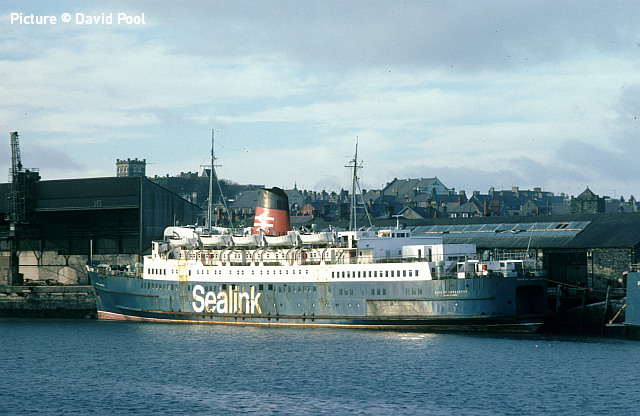
On Christmas Day 1978 the TSS Duke of Lancaster was an unusual resident at Holyhead. It had been built by Harland and Wolff as a passenger ship for the Heysham to Belfast route and also for occasional cruising, entering service in 1956. By the late 1960s the need was for car ferries, and in 1970 the Duke of Lancaster was converted to carry cars, returning to the Heysham to Belfast route until this service was withdrawn in 1975. In 1978 it had been used as a relief vessel between Holyhead and Dun Laoghaire, but her sailing days came to an end in 1979, when I was astonished to see her in the River Dee near Mostyn. The following day it was seen to have been beached, and thereafter has suffered a number of indignities, from a deck of slot machines to Graffiti decoration. 'The Duke' survives today, but her future is far from clear.
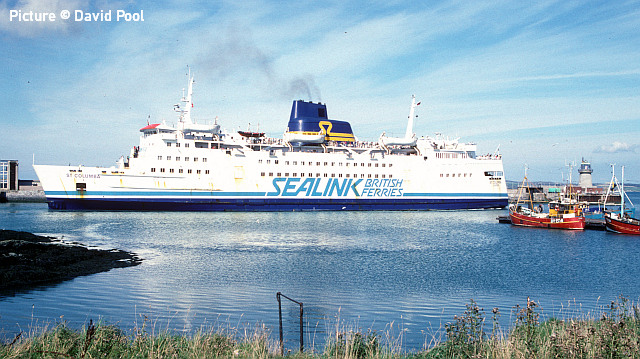
One of the most popular ships at Holyhead was the St. Columba, which operated almost exclusively on the Holyhead to Dun Laoghaire route from 1977 to 1990. Built in Denmark in 1977, it could carry 1700 passengers and 335 cars. In 1991 it received a refit and a new name, the Stena Hibernia, and returned to Holyhead until 1996, and sold to begin a new life in the Middle East, where it may still be found today. On 3 September 1989 the ship makes an impressive sight leaving Holyhead, the bow door having just closed. I needed a wide angle lens for this shot!
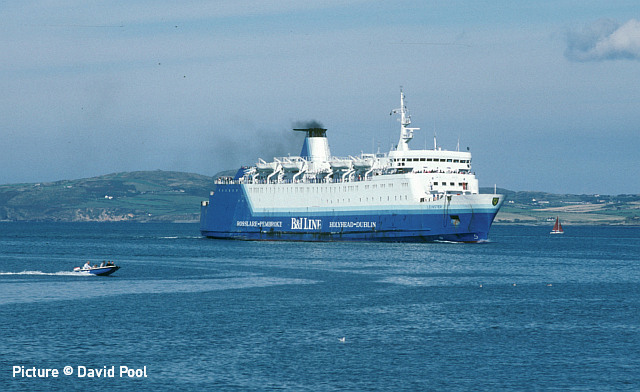
On the same day the incoming B & I line vessel was the Leinster, arriving from Dublin. Getting the speedboat and the sailing dinghy in the shot was a challenge! This ship had been built at Cork in 1981, and used on the overnight Liverpool to Dublin service, until this was withdrawn as unprofitable in 1988. Renamed Isle of Inishmore in 1993, the ship finally moved to Canada as the Madeleine, where it may still be in service.
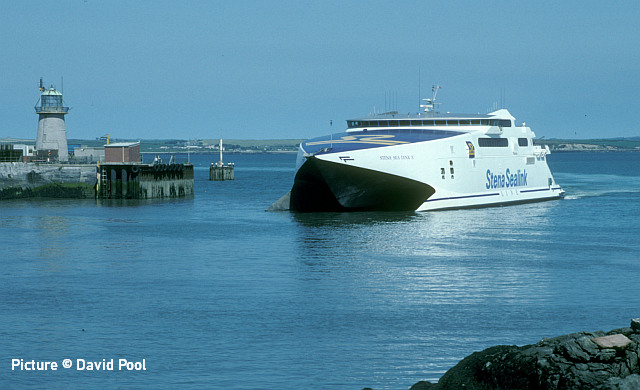
The first car carrying catamaran at Holyhead was the Stena Sea Lynx, built by Incat of Tasmania in 1993, it was an immediate success. Stena then chartered a larger vessel from Buquebus of Uruguay, the Stena Sea Lynx II, seen on 24 June 1994 arriving at Holyhead, replacing the Sea Lynx which was moving to Fishguard. Later it returned to Buquebus, and after operating in the Mediterranean was eventually sold to Balearia and renamed Jaume I. The vessel is currently registered in Malta.
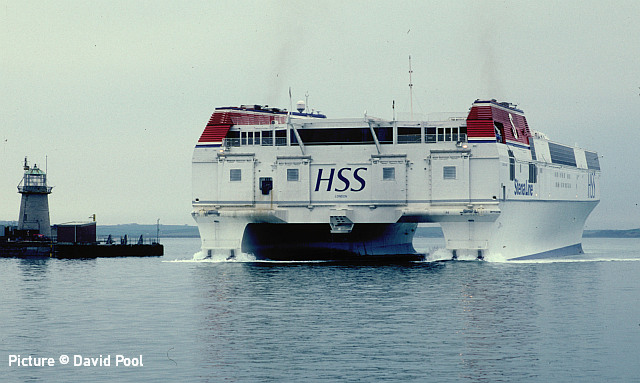
The success of the catamarans led to Stena getting an even larger vessel in 1996. The Stena Explorer was built in Finland, and advertised as giving a High Speed Sea-Service (HSS). It is not the most beautiful of vessels, and as it came astern towards the car loading linkspan the box-like superstructure on twin hulls is illustrated well. Described as one of the largest high speed catamarans in the world, it can carry 1500 passengers and 375 vehicles at a service speed of 40 knots. Withdrawn from service in 2015, it moved to Turkey, being at first used aa a floating office, and then offered for sale at £4.5 million.
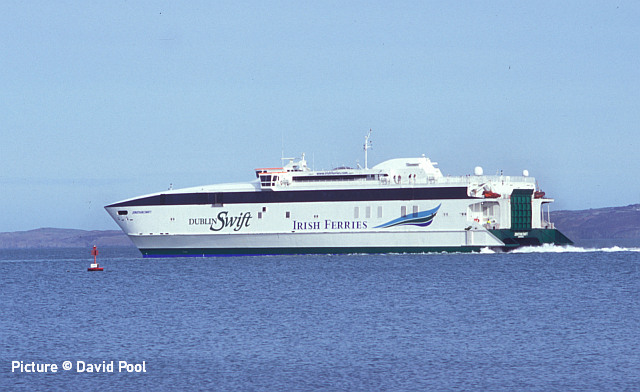
Irish Ferries, with services between Holyhead and Dublin, were using conventional vessels until the arrival of their first fast ferry in 1999. The Jonathan Swift is a twin hull catamaran, and has bow and stern doors for rapid loading and unloading of up to 200 cars (or equivalent) plus 800 passengers. Built by Austal Ships (Australia), it has four Caterpillar diesel engines, and a service speed of 40 knots. In 2018 it was sold for £15.5 million to Balearia, and renamed Cecilia Payne. The photograph was taken on 16 February 2018, shortly before it moved to the Mediterranean.
Llangollen scenes
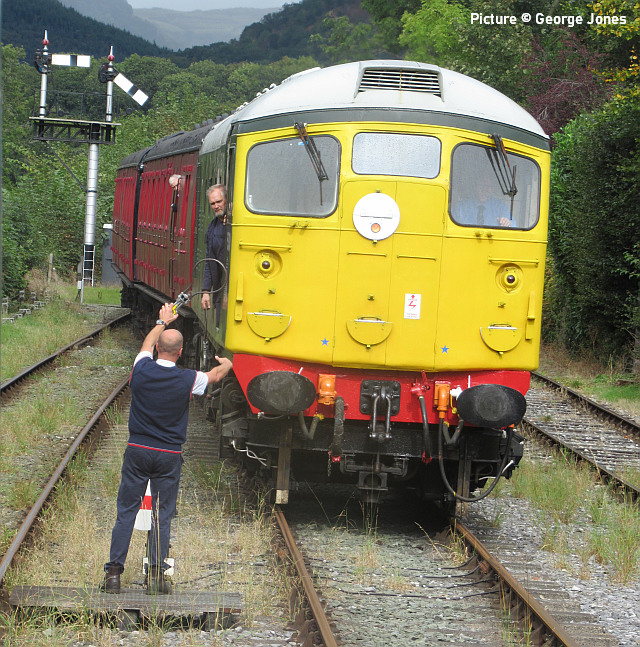
George Jones writes: 'The weekend services offered three diesel loco hauled services with the suburban set and two DMU services. The class 26 5310 brought the first train of the day back into Llangollen, seen exchanging the token at Goods Junction. The driver paused to tell the signalman there were people on the track west of Dee Bridge and a warning for the DMU driver although no one was seen on Berwyn Bank.
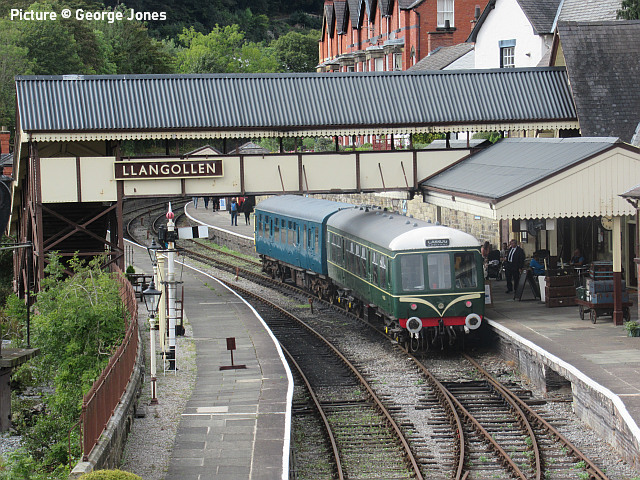
'Llangollen Railcars rang the changes and rostered the hybrid 104/108 set, M50454 and M56223 seen in Llangollen station on return from Carrog with its contrasting blue and green liveries. The first signs of autumn are now evident in the Dee valley making for a pleasant run down the line with patronage holding up despite the absence of steam.'
Ken Robinson writes: 'I visited the Llangollen Railway on 26 September upon hearing that 31 271 would be on the passenger service for the first time in around 12 months - apparently 31 271's stay on the line has been extended.
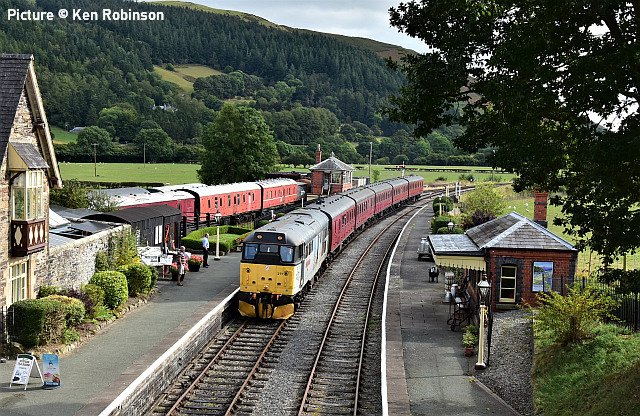
31 271 arriving at Carrog with the 10:30 from Llangollen. This was its first passenger train on the Llangollen Railway for around 12 months.
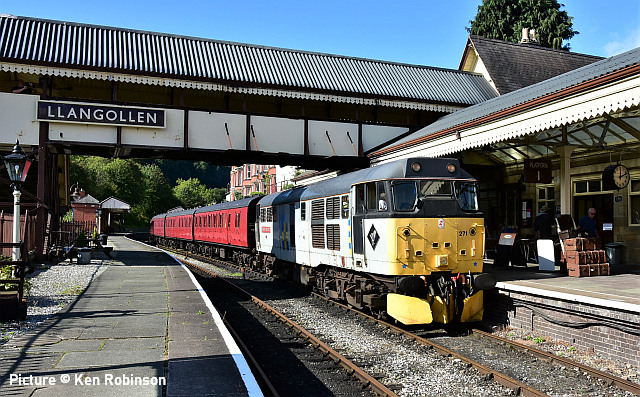
'After a spirited and very enjoyable journey to Llangollen with 31271, this was the scene after arrival with the 11:32 from Carrog.'
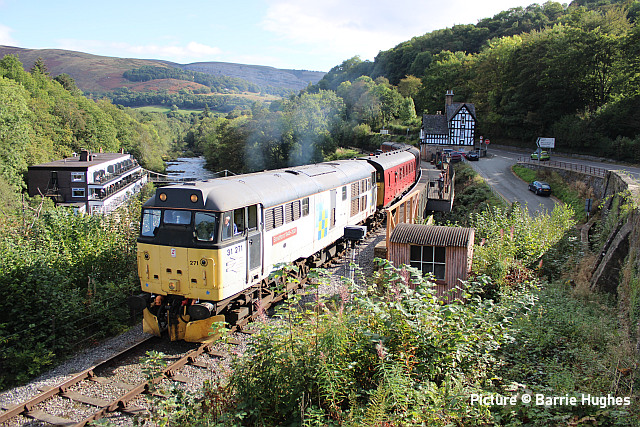
Barrie Hughes also visited: here's 31 271 at Berwyn.
North Wales Coast home page | Archive | Previous Notice Board